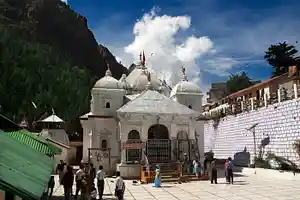Gangotri Temple - Stories and Legends about the Home of Goddess Ganga
Home » Gangotri Dham »
 The Dham of Gangotri is perched at an elevation of 3,100 metres above sea level in the scenic village of Uttarkashi of the picturesque Himalayan ranges. This place is extremely highly revered among the devout Hindus for being an important part of the Chota Char Dham Yatra. Nestled gracefully among the mighty snow-clad mountain peaks this gleaming white temple is one of the holiest destinations along with the other 3 destinations of Kedarnath, Badrinath and Yamunotri. Dedicated to Maa Ganga, this temple marks the origin of the most pious river of India, Ganga, which is that of Gangotri glacier. It is this place where Maa Ganga had descended from the heavenly realm to the earthly realm. The glacier can be accessed by high altitude trekkers and adventure enthusiasts by covering a trekking distance of 19 kms from the main Dham Shrine of Gangotri. The holy shrine is nestled comfortably among the lush greenery and thick forest cover close to the border of India and Tibet, making it an awe-inspiring picnic destination for outdoor travel lovers.
The Dham of Gangotri is perched at an elevation of 3,100 metres above sea level in the scenic village of Uttarkashi of the picturesque Himalayan ranges. This place is extremely highly revered among the devout Hindus for being an important part of the Chota Char Dham Yatra. Nestled gracefully among the mighty snow-clad mountain peaks this gleaming white temple is one of the holiest destinations along with the other 3 destinations of Kedarnath, Badrinath and Yamunotri. Dedicated to Maa Ganga, this temple marks the origin of the most pious river of India, Ganga, which is that of Gangotri glacier. It is this place where Maa Ganga had descended from the heavenly realm to the earthly realm. The glacier can be accessed by high altitude trekkers and adventure enthusiasts by covering a trekking distance of 19 kms from the main Dham Shrine of Gangotri. The holy shrine is nestled comfortably among the lush greenery and thick forest cover close to the border of India and Tibet, making it an awe-inspiring picnic destination for outdoor travel lovers.
Legends:
The descending of the holy Ganga River is one of the most widely acclaimed and powerful mythological legends in Hindu literary works. According to the legend, King Sagar, whose great-grandson was King Bhagirath, had slayed all the earthly demons. In order to assert his dominance and supremacy he decided to perform the Ashwamedha Yagna. As per the rules of the yajna one horse was supposed to be let loose and was expected to go across various empires on an uninterrupted journey. This worried the supreme ruler, Indra who feared that he might lose his celestial throne after the completion of this yagna. With the help of his various celestial powers Lord Indra quietly tied this horse to the ashram of sage kapila who, during that time was in a deep meditative state. The king’s agents soon came to the realization that they were no longer aware of the tracks of the horse. In order to gain control of the horse once again, the king summoned his 60,000 sons to look for the horse and bring it back. While looking for the horse his sons came across the sage’s hamlet and saw the horse tied next to him. The sons fiercely stormed inside the sage’s hut, disturbing the meditating sage and accused him for stealing their horse. Being disrupted the sage glanced at them and turned them into ashes with just one look. He also cursed at them and said that their souls would attain moksha only after their ashes are washed away in the holy water of river Ganga. In order to free their souls King Bhagirath performed vigorous penance for 1000 years that finally convinced and pleased goddess Ganga to descend to earth.
The Story of River Ganga:
The legendary tale of origin for the holy river of Ganga dates back to the time when goddess Ganga had agreed to answer the penance of King Bhagirathi. However it was believed that once the intensity with which this mighty and heavenly river will descend to the earthly realm it would cause a massive destruction and destroy the earth completely. In order to save and protect the earth form such destructions, Lord Shiva decided to help by catching the river in his matted locks and directing the river in the form of 3 different streams in order to lower its destructive effects on earth. One of these streams was known as Bhagirathi River. The place where king Bhagirathi had served his penance and did some rigorous mediation has been marked in the form of Bhagirathi Shila, a black mountain stone structure. It is also believed that the moment the water of the holy river touched the earth all the restless souls of King Bhagirath’s ancestors attained their salvation.
Architecture:
Initially, before the construction of the current shrine, Gangotri was a small shrine space. Later on in the 18th century the Gangotri temple was renovated to its present shape and form. The temple was constructed by the ‘living lion of Nepal’, Amar Singh Thapa the Gurkha army chief. The construction took place keeping in mind the style and designs of any north Indian temple. The white granite which was utilized for the construction of the temple is simple, clean and lacks any elaborate carvings or engravings. The temple rises till 20 feet in height and stands out due to its stark white color. The idol of goddess Ganga is placed inside the garbha griha which can be reached after walking through an ordinary looking entrance. The temple is composed of 3 primary cupolas which are decorated and beautified with the help of olden spires. Although the temple architecture is quiet basic and not at all opulent, the religious and spiritual significance of this dham shrine is unparalleled.


Leave a Reply